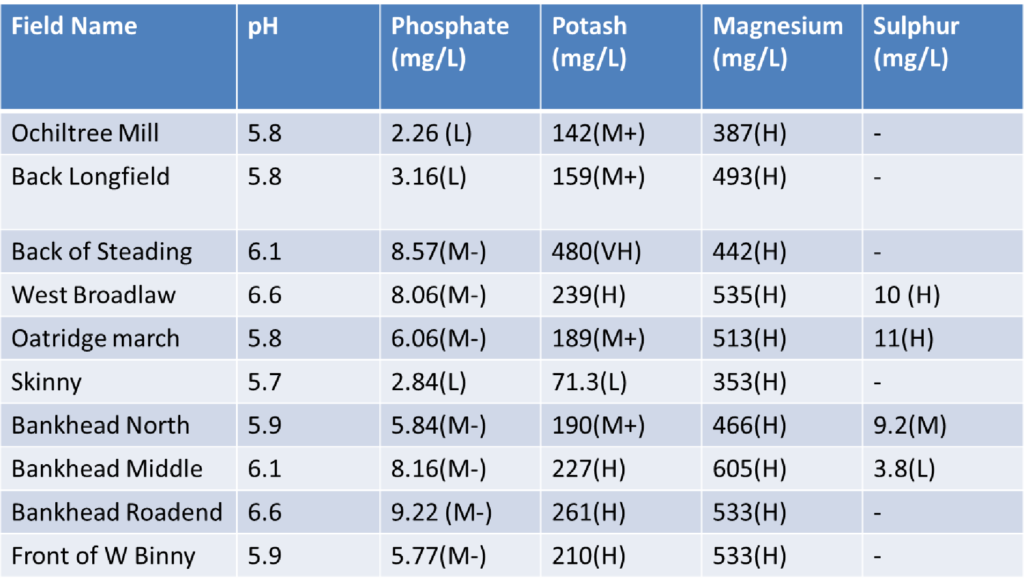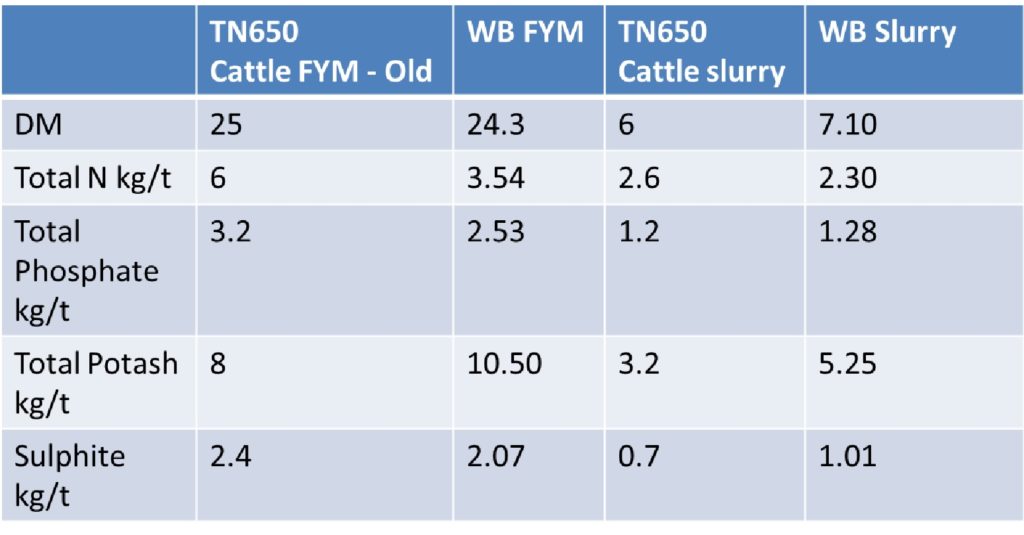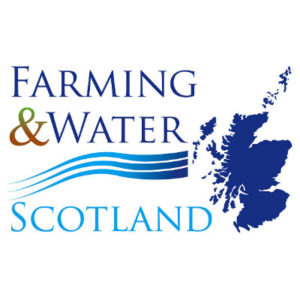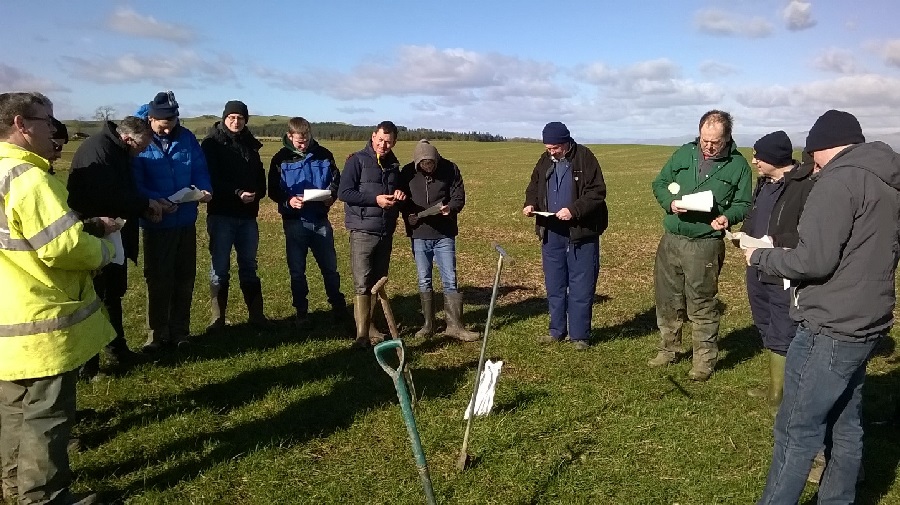Soil & Nutrient Network – Case Study: West Binny Farm, West Lothian
3 March 2017Introduction to West Binny Farm
The Russell family farm West Binny in conjunction with Drumcross which lies in the Bathgate Hills, West Lothian, at an altitude of around 660 ft. above sea level. Soil types are Darleith which is freely drained and Winton which is imperfectly drained.
The farms are mixed beef, sheep and arable with a dairy herd at Drumcross. Followers from the dairy are reared at West Binny alongside the suckler cows and finishers. Cattle are on a mixture of cubicle and slats based slurry systems as well as straw bedded courts.
West Binny covers 82.15ha of which 79.92ha is ploughable and either sown as temporary grass or winter barley.
Analysis – Where we are…
The first step in the project was to soil sample the fields at West Binny for pH, P, K & Mg. Some fields were also sampled for S.
This is essential when calculating fertiliser requirements and lime applications for cropping.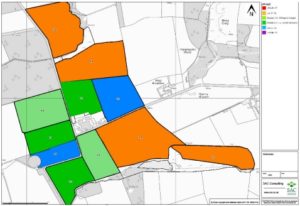
Of the fields analysed around half of the fields were on target pH of 5.9 for grassland with most needing some lime to increase to the higher target of 6.3 for arable cropping. The analysis found three fields which were low in phosphate and one field low in potash.
These fields were located further away from the steading which has proved more difficult to transport organic manures to.
The rest of the fields were either moderate for phosphate or moderate and high for potash. The high analysis gave the opportunity to make savings on bagged P & K.
VESS guide and soil texture
During the first meeting Gavin Elrick , SAC Consulting soil and drainage specialist, talked the group through the Visual Evaluation of Soil Structure (VESS) guide and how to determine your soil texture.
The VESS guide gives guidance on how to identify areas of good soil structure and those compacted soils and will allow you to make informed decisions on whether or not to rectify potential compaction issues.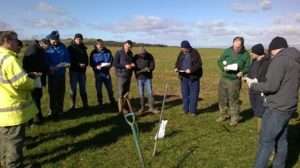
To carry this out you should identify areas of concern within the field whether that is water logged areas or field gates.
A spadeful of soil should be dug out of the area and placed on the surface. You can begin to break the soil apart and the nature of the soil can be compared to the VESS guide. Soils are split into 5 categories with 1 being friable soils and 5 being very compact. Soils with scores 4 or 5 will need some form of subsoiling/cultivation in order to reinstate a friable soil structure.
Gavin also showed how to assess your soil texture by taking a spoonful of soil, moistening it and following the assessment flow chart.
Knowing your soil types can be important in your understanding of nutrients and how different soils are more prone to leaching of nutrients etc.
Nutrient budgeting
In order to demonstrate a potential fertiliser saving a full nutrient budget was completed for the farm.
The budget highlighted the vast quantity of nutrients present on the farm within slurry and FYM.
From knowing the crop yield we were able to work out the offtake of nutrients. With the current soil status the farm would be self sufficient in P & K for the area of silage it grows. It was observed from the initial soil analysis taken in 2017 and the soil analysis taken in 2018 that soil indices for P & K had risen slightly. Therefore with a number of soils at above target status there was potential to make more savings on organic manure applications and focus applications on the two low fields. The difficulty with this was that the fields low in P & K are those furthest from the steading and are also wetter fields. Historically this would have been the reason that these fields haven’t had slurry or dung on them in the past.
Slurry Storage
The group also had a look at the slurry storage at West Binny.
Before the Russells purchased the farm in 2015 the slurry tower had not been used and the reception pit was in a state of disrepair.
The group discussed what would be required to get the slurry tower back in action to allow the farm storage capacity to be in excess of 6 months. This would allow for greater flexibility in the spreading of slurry during the spring as grass growth starts.
For winter 2018 the slurry tower will be in action which will be of environmental and economic benefit.
Organic manures and their values
The nutrient value of the slurry and FYM on the farm was also analysed. The key to an organic manure analysis is in selecting as representative a sample as possible, so sampling numerous points on a dung heap or mixing slurry before sampling is extremely important.
The analysis showed that the potash values were higher than standardised book figures (TN650). This would be expected with farms with high potash levels in the soil. This further highlighted the opportunity to save on bagged K. The phosphate is very similar to the book figures and the total Nitrogen less than standard figures. A major influence on the analysis is the diet that livestock are fed.
GPS Soil analysis
After soil sampling using the conventional ‘W’ shaped pattern across the field to determine pH we decided to look into GPS soil sampling in order to determine the variation within the fields.
The GPS soil analysis consisted of fields being split into a grid pattern based on 4 pH samples per ha. We also split the P & K sample areas based on historic field boundaries and soil type maps.
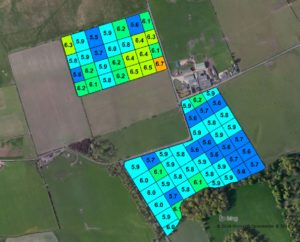
The pH maps highlighted the areas that were low in pH in comparison to those higher. Variability can be due to a number of reasons, although mainly affected by lack of consistency when spreading. Although highly variable the pH was good in both fields. The lowest areas were 5.6 which raised to 6.4, ignoring abnormally high pHs found in gateways.
By analysing the fields by GPS we can get an accurate picture of areas of low and high pH and treat them accordingly.
The GPS sampling allowed for a saving of 18.56 tonne of lime over 18.11ha. This more than covered the additional costs of GPS sampling.
Silage mineral analysis
Following analysis of the soil and organic manures, the silage was then analysed to measure the minerals. The aim of this was to demonstrate crop offtake and to highlight the importance of phosphate and potash for growing silage crops.
The analysis shows that 2.1% of the dry matter of the silage is made up of potassium. In comparison, phosphorous only accounts for 0.25% of the dry matter. In a silage crop it is extremely important that a source of potassium is applied to avoid depleting soil reserves below the target status.
The silage pit capacity at West Binny at 2.75 metres high is 3,000 tonnes. During 2017 there were 54.38 ha cut for grass silage mainly over two cuts. This gave a yield of 2,100 t, which calculates to an average of 42t/ha. This piece of information is very important; without knowing the yield then targeting fertiliser applications becomes an estimation.
When calculating the crop offtake, analysis showed a requirement of 62kg/ha of P2O5 and 264 kg/ha K2O was required. As a comparison this equates to 6.78 tonnes of triple super phosphate and 22.13 tonnes of muriate of potash, most of which came from organic manures.
Tyre selection and soil compaction
With soil compaction being topical after a very wet harvest there was a discussion on ways to reduce the risk of causing compaction through tyre selection and managing tyre pressures.
Information from the Castlemains Climate Change Focus Farm demonstration was shared with the grou
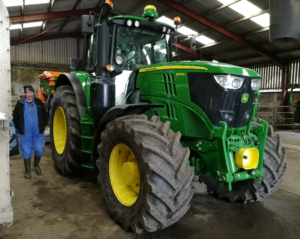
p. When selecting tyres on a new tractor, trailer or when due for replacement, it is important to consider the application before selecting tyres. Tyres have to cover a number of tasks and general purpose tyres are often purchased.
If doing a lot of cultivations on top of ploughing consider purchasing wider tyres with technology in the tyre design which can allow them to be run at lower pressures.
It is also important to know the load imposed on the tractor in order to calculate the optimum tyre pressure. Tyre manufacturers will have booklets to describe this process.
Further information can be found in the Farming For a Better Climate Practical Guide: Tyre Selection & Management
Key findings
- Analyse your soils and organic manures routinely.
- Carry out a nutrient budget with potential for fertiliser savings.
- Consider GPS soil analysis for pH next time you plan on liming.
- Dig a soil pit in order to investigate soil structure and potential problems.
- Look at different options for tyres on tractors and trailers.
For dates of SNN events, find us on Facebook or follow us on Twitter @FASScot ![]()
![]()
Use these links to read event summaries from the first, second and third meetings of the West Lothian group.
Sign up to the FAS newsletter
Receive updates on news, events and publications from Scotland’s Farm Advisory Service

